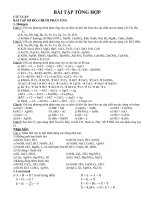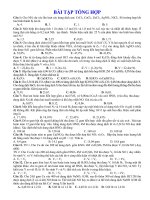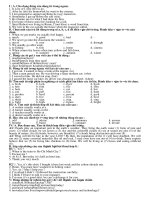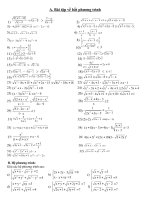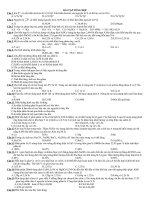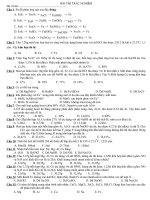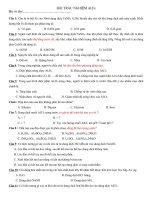Bài tập tổng hợp - A1-16, A2-16, A3-16
Bạn đang xem bản rút gọn của tài liệu. Xem và tải ngay bản đầy đủ của tài liệu tại đây (242.76 KB, 7 trang )
<span class='text_page_counter'>(1)</span><div class='page_container' data-page=1>
482
<b>PCR DETECTION OF BOVINE HERPESVIRUSES FROM NONBOVINE</b>
<b>RUMINANTS IN HUNGARY</b>
<b>Do´ ra Ka´lma´n</b>1<b><sub>and La´szlo</sub><sub>´ Egyed</sub></b>1,2
1<sub>Veterinary Medical Research Institute of the Hungarian Academy of Sciences, PO Box 18, H-1581 Budapest,</sub>
Hungary
2<sub>Corresponding author (email: )</sub>
ABSTRACT: Polymerase chain reaction (PCR) was used to test six different nonbovine ruminant
species for five bovine herpesviruses including infectious bovine rhinotracheitis virus (BoHV-1),
bovine herpes mammillitis virus (BoHV-2), Movar-type herpesvirus (BoHV-4), bovine herpesvirus
type 5 (BoHV-5), and alcelaphine herpesvirus 1 (AlHV-1). Species tested included 56 roe deer
(<i>Capreolus capreolus</i>), 66 red deer (<i>Cervus elaphus</i>), 20 fallow deer (<i>Dama dama</i>), 16 mouflon
(<i>Ovis musimon</i>), 34 domestic sheep, and 44 domestic goats, which were sampled in Hungary in
2003. Tracheal and popliteal lymph nodes collected from these animals were tested for the
pres-ence of the five bovine herpesviruses using three nested (two of which were duplex) PCR assays.
Three bovine herpesviruses (BoHV-1, -2, and -4) were detected, whereas no evidence of
AlHV-1 or BoHV-5 was observed. Prevalence of BoHV-AlHV-1 ranged from AlHV-12% to 47%, and PCR-positive
results were observed in all species tested. BoHV-2 was detected from roe deer, red deer, fallow
deer, mouflon, and domestic sheep, and the prevalence in these species ranged from 3% to 50%.
BoHV-4 was detected in all species, with prevalence ranging from 12% to 69%. Sequenced PCR
products were 99-100% identical to bovine herpesviral sequences deposited in the GenBank.
<i>Key words:</i> Alcelaphine herpesvirus 1, AlHV-1, BoHV-1, BoHV-2, BoHV-4, BoHV-5, bovine
herpesviruses, cervids, deer, PCR.
<b>INTRODUCTION</b>
Although evidence of bovine
herpesvi-ruses in free-ranging wildlife species has
been reported, the risk of intraspecies
transmission, especially between wildlife
and domestic livestock, is poorly
under-stood. Antibodies to bovine rhinotracheitis
virus (bovine herpesvirus type 1, BoHV-1)
have been reported from seven European
countries (Froălich et al., 2002) but less
than 1% of red deer (<i>Cervus elaphus</i>) and
roe deer (<i>Capreolus capreolus</i>) proved to
be positive for BoHV-1 in France and
Bel-gium (Thiry et al., 1988). BoHV-1 was
iso-lated from water buffalo (<i>Bubalus </i>
<i>cara-banesis</i>) in Malaysia (Ibrahim et al., 1983)
and detected by serology in Brazil (Lage
et al., 1996). Antibodies to BoHV-1 also
have been reported from wildebeest (<i></i>
<i>Con-nochaetes taurinus</i>) and cape buffalo (<i></i>
<i>Syn-cerus caffer</i>) (Rweyemamu, 1970),
hippo-potamus (<i>Hippopotamus amphibious</i>)
(Ka-minjolo et al., 1970) and black-faced
im-pala (<i>Aepyceros</i> <i>melampus</i> <i>petersi</i>)
(Karesh et al., 1997) in Africa, and from
American bison (<i>Bison bison</i>) (Taylor et
al., 1997) in the USA. However, these
se-rologic investigations did not differentiate
between BoHV-1 and possible
cross-reac-tions with other related herpesviruses.
Alcelaphine herpesvirus 1 (AlHV-1,
strain WC-11), which causes
wildebeest-associated malignant catarrhal fever
(WA-MCF), originally was isolated from blue
wildebeest (<i>Connochaetes taurinus </i>
<i>tauri-nus</i>) (Plowright et al., 1960). This virus
was has been reported from
white-beard-ed (<i>Connochaetes taurinus albojubatus</i>)
and white-tailed wildebeest (<i>Connochaetes</i>
<i>gnou</i>) (Seal et al., 1989). Several other
her-pesviruses have been isolated from African
exotic ruminants, deer, bison, gaur (<i>Bos</i>
<i>gaurus</i>), greater kudu (<i>Tragelaphus </i>
<i>strep-siceros</i>), and others, but the relation of
these viruses to AlHV-1 strain WC-11 has
not been reported (Castro et al., 1982;
Seal et al., 1989; Blake et al., 1990; Li et
al., 2000).
Evidence of malignant catarrhal fever
(MCF) infection in free-ranging European
ruminants is restricted to a single MCF
case that was diagnosed by histopathology
in wild moose (<i>Alces alces</i>) in Sweden
</div>
<span class='text_page_counter'>(2)</span><div class='page_container' data-page=2>
of seropositive free-ranging fallow deer
(<i>Dama dama</i>) (Froălich et al., 1998). It is
likely that most MCF reports in European
deer are associated with sheep-associated
MCF (SA-MCF) caused by Ovine
herpes-virus 2 (OvHV-2). Evidence of bovine
her-pesvirus type 2 (BoHV-2) in wild ungulates
in Europe is restricted to the detection of
antibodies in two female European bison
(<i>Bison bonasus</i>) that had virus
neutraliza-tion titers of 20 against BoHV-2 (Borchers
et al., 2002).
In contrast to other bovine
herpesvirus-es, bovine herpesvirus 4 (BoHV-4) infects
a wide variety of species and replicates in
various cell lines. A herpesvirus isolated
from thyroid and adrenal glands and from
the spleen of an American bison affected
with MCF (Todd and Storz, 1983) was
identified as BoHV-4 by indirect
immu-nofluorescence assay (IIF) and restriction
enzyme cleavage (RE) (Storz et al., 1984).
Eleven isolates of BoHV-4 from peripheral
blood leukocytes of 45 healthy, one
se-verely ill, and one dead African cape
buf-falo also were identified as BoHV-4 by IIF
and RE (Rossiter et al., 1989). A
herpes-virus isolated from a kidney cell culture of
a healthy owl monkey (<i>Aotus trivirgatus</i>)
and another isolate from a cat suffering
from urolithiasis later were identified as
BoHV-4 strains (Bublot et al., 1991;
Fab-ricant and Gillespie, 1974). This virus also
has been isolated from the spleen of a
cap-tive lion (<i>Panthera leo</i>) (Bartha, pers.
comm.; Bartha et al., 1989).
Bovine herpesvirus 5 (BoHV-5) has
been associated with rare cases of
enceph-alitis in cattle and was previously
consid-ered an encephalitic form of BoHV-1/IBR.
Sheep are susceptible to experimental
in-fection (Bela´k, et al., 1999), but there is
no evidence of BoHV-1 infection in
Eu-ropean wildlife.
Serological testing for antibodies to
bo-vine herpesviruses can be complicated by
cross-reactions between antigenically
re-lated viruses and the failure to detect
la-tently infected individuals. In this study,
we used PCR to test for four bovine
her-pesviruses and AlHV-1 in four wildlife
spe-cies (roe deer, red deer, fallow deer, and
mouflon) and two domestic species (goats
and sheep) in Hungary.
<b>MATERIALS AND METHODS</b>
Tracheal and popliteal lymph nodes were
collected from 66 red deer, 20 fallow deer, 56
roe deer, and 16 mouflon. All samples were
from healthy free-ranging animals that were
shot by professional hunters from September
to December 2003 in all counties of Hungary.
Samples were frozen at220 C for 1–2 mo
be-fore PCR testing.
Samples of 34 sheep and 44 goats (lymph
nodes and spleens) were also collected from
healthy animals that were euthanized at
abat-toirs and from animals submitted for diagnostic
examination to the Veterinary Diagnostic
Insti-tute Budapest. All sheep and goat samples
orig-inated from northern Hungary.
For sample preparation, thawed tissues were
homogenized in mortars and digested with
Pro-teinase-K (Sigma-Aldrich Co., St. Louis,
Mis-souri, USA) at 50 C overnight. Cell debris was
sedimented by centrifugation (15,2003 G for
1 min). DNA was purified from supernatant
us-ing a Miniprep Express Matrix Kit (Qbiogene
Inc., Carlsbad, California, USA) as directed by
the manufacturer.
For the detection of BoHV-1 and BoHV-5, a
duplex nested PCR with GC1, CR1, and CR26
primers was used (Ros et al., 1999). For the
detection of BoHV-4 and AlHV-1, a duplex
nested PCR assay was used (Fa´bia´n and Egyed,
2004). To detect BoHV-2, a novel nested PCR
was developed to amplify a sequence of the
gly-coprotein H (gH) gene. The gH sequence was
obtained from the GenBank European
Molec-ular Biology Laboratory (EMBL) data bank
(accession number AF 375976), and the
follow-ing oligonucleotides were selected as primers:
MAM-1: 59-GTT TGA CGC TGG CTT AGT
GG-39; MAM-2: 59-TAT CAG GAT TAC CCC
GAC CC-39; MAM-3: 59-TGA CGC TGG CTT
AGT GGG TA-39, and MAM-4: 59-CGG TAG
GTA TAG ACG GTC GCT C-39. The outer
primers (MAM-1 and MAM-2), flanked a
276-bp fragment; the inner primers (MAM-3 and
MAM-4) amplified a 237-bp long product. The
PCR amplifications were carried out in 50-ml
reaction mixtures containing 5-ml of 103PCR
buffer (100 mM of Tris [pH 9.0], 500 mM of
KCl, 1 mg of bovine serum albumin per ml),
100 M of (each) deoxynucleoside triphosphate
(Pharmacia Biotech, Uppsala, Sweden), 15
pmol of each primer, 1 U of <i>Taq</i> DNA
poly-merase (Fermentas AB, Vilnius, Lithuania.), 6
</div>
<span class='text_page_counter'>(3)</span><div class='page_container' data-page=3>
(max-FIGURE1. Optimizing results for bovine herpesvirus type 2 polymerase chain reaction (PCR): (A)
Opti-mizing kit (MgCl<sub>2</sub>, KCl, pH) results; (B) Optimal annealing temperatures (Tgradient PCR).
imum of 0.9 mg of total DNA per reaction).
The aqueous phase was overlaid with 2–3 drops
of mineral oil (Sigma-Aldrich). The 30
ampli-fication cycles included denaturation at 94 C
for 45 sec, annealing at 62 C for 1 min, and
synthesis at 72 C for 1 min. After the last cycle,
the tubes were kept at 72 C for 10 min to
com-plete the extension, and mixtures were cooled
to 4 C. From the first PCR product, 1ml was
transferred into the second reaction. Except for
modifications in the concentration of MgCl2(3
ml of 25 mM) and the annealing temperature
(64 C), the previously described PCR protocol
was followed. For the second round, 62–64 C
annealing temperatures seemed to be optimal;
we selected the higher temperature to increase
specificity. DNA extracted from purified
BoHV-2 and distilled water served as positive
and negative controls. The optimal annealing
temperature (62 and 64 C) was determined by
gradient PCR in Tgradient Whatman Biometra
device (Analytik GmbH, Goettingen,
Germa-ny). For further optimization, the PCR assay
was analyzed by a PCR Optimization Kit II
(Sigma-Aldrich).
The PCR products were analyzed by
electro-phoresis in 2% agarose gels using 0.53
Tris-bo-rate-ethylenediaminetetraacetic acid (EDTA)
running buffer. Ethidium bromide-stained
bands were visualized with ultraviolet (UV)
light and recorded with a video camera (Kodak
EDAS 290, Hemel, Hempstead, UK). The
mo-lecular sizes of fragments were compared with
those of a GeneRulery 100-bp ladder
(Fer-mentas AB, Vilnius, Lithuania).
Specificity of the assay was checked against
11 animal and human herpesviruses (BoHV-1,
-2 [Allerton strain] -4, -5, AlHV-1, equid
her-pesvirus 1, -2, -5, suid herher-pesvirus 1, murid
herpesvirus 1, human herpesvirus 4). Bovine
cell genome was also tested using the
Madin-Darby bovine kidney cell line. Sensitivity
stud-ies were carried out by determining PCR
de-tection limits from various dilutions of titrated
BoHV-2 Allerton strain (100, 10, and 1 plaque
forming units [pfu] per reaction). All PCR
as-says were carried out using previously reported
precautions to prevent cross-contamination
(Bela´k and Ballagi-Porda´ny, 1993). To confirm
the specificity of results, one positive field
sam-ple, representing each detected virus, was
se-lected for sequencing. The sequences were
aligned with the corresponding viral sequences
of the data bank by the program BLASTN 2.2.7
(Altschul et al., 1997).
<b>RESULTS</b>
The outer and inner primers used in the
BoHV-2 PCR assay could detect 100 pfu
in a single reaction (two positives from
three reactions). In the nested assay,
sen-sitivity was increased to 1 pfu (five
posi-tives from five nested reactions) of
BoHV-2. Positive results were not detected for
any of the other ten herpesviruses used to
assure assay specificity. Amplification with
the outer primers was most efficient at
higher (30-35 mM) concentration of
</div>
<span class='text_page_counter'>(4)</span><div class='page_container' data-page=4>
in-Figure 2. Polymerase chain reaction (PCR) amplification of bovine herpesviruses from nonbovine species.
Lines 1–5 BoHV-1 (478 bp), lines 7–9 BoHV-2 (237 bp), lines 11–16 BoHV-4 (271 bp), 100 bp ladder: M, a
negative BoHV-2 sample: C. Roe deer: 1, 11. Red deer: 2, 7, 12. Fallow deer: 3, 8, 13. Mouflon: 9. Sheep:
4, 15. Goat: 5, 16.
TABLE1. Polymerase chain reaction (PCR) detection of the bovine herpesviruses (BoHV) types -1, -2, -4,
and -5 and alcelaphine herpesvirus 1 (AIHV-1) from nonbovine ruminant species.
BoHV-1 BoHV-2 AIHV-1 BoHV-4 BoHV-5
Roe deer
Red deer
Fallow deer
Mouflon
Sheep
Goat
56/12 (21.4%)
66/19 (28.8%)
20/7 (35.0%)
16/2 (12.5%)
34/16 (47.0%)
44/13 (29.5%)
56/4 (7.1%)
66/3 (4.5%)
20/1 (5.0%)
16/8 (50%)
34/1 (2.9%)
44/0
56/0
66/0
20/0
16/0
34/0
44/0
56/7 (12.5%)
66/14 (21.2%)
20/8 (40.0%)
16/11 (68/7%)
34/9 (26.5%)
44/6 (13.6%)
56/0
66/0
20/0
16/0
34/0
44/0
ner primers were optimized at pH 8.8 at
15 mM of MgCl2. Temperature-gradient
PCR indicated peak amplification at 62 C
with the outer primers and 64 C with the
inner primers.
Positive PCR results were observed for
BoHV-1, -2, and -4 but not AlHV-1 or
BoHV-5 (Fig. 2). Results for individual
species and viruses are shown in Table 1.
Double infections were rare: two roe
deer, two red deer, two sheep, and one
goat were infected with both BoHV-1 and
BoHV-4; one roe deer was infected with
BoHV-1 and BoHV-2.
Sequenced PCR products were similar
or nearly identical (99-100%) to GenBank
sequences of glycoprotein H gene of
BoHV-2 (AF375976), glycoprotein C gene
of BoHV-1 (AJ004801), and the major
cap-sid protein gene of BoHV-4 (AF318573)
and proved to be specific amplifications of
bovine herpesviruses. No variant strains,
mutations, deletions, or insertions were
found.
<b>DISCUSSION</b>
</div>
<span class='text_page_counter'>(5)</span><div class='page_container' data-page=5>
mouflon populations in Europe. Our data
indicate that roe deer, red deer, fallow
deer, and mouflon can be infected with
bovine herpesviruses and that PCR
pro-vides a reliable approach to survey other
European populations of these species.
Variation in the proportion of infected
an-imals appears to exist between species
(Ta-ble 1), but additional samples and a
more-controlled sampling protocol to address
variables that could potentially affect
prev-alence (e.g., age, location, population
den-sity) are needed to fully evaluate these
po-tential differences.
The detection of BoHV-1 in nonbovine
species may be most important, especially
in relation to the eradication or control of
this virus in European livestock. Our
re-sults show that the virus is widespread in
free-ranging and livestock ruminant
spe-cies. High numbers of roe deer and red
deer exist in Europe, and based on our
results, it is possible that a high proportion
are infected with BoHV-1. However, the
potential for transmission of this virus
be-tween species is not fully understood.
Herpes mammillitis exists in the
Hun-garian cattle population, but clinical signs
are only occasionally observed (Rusvai,
pers. comm.). The 4–7% prevalence of
BoHV-2 among free-ranging deer suggests
a low prevalence of infection in these
spe-cies but provides incomplete information
on which to evaluate the reservoir status.
Very low infection rates in sheep (3%) and
goats (0%) were unexpected and suggest
that these domestic species probably do
not play a major role in the epidemiology
of BoHV-2. The optimized BoHV-2 PCR
assay proved to be a suitable tool for
de-tecting BoHV-2 DNA, and it is not
be-lieved that these low prevalence estimates
reflect problems with assay sensitivity.
Alcelaphine herpesvirus 1 was not
de-tected, even though PCR positives were
recently detected in 40% of a Hungarian
cattle population (Fa´bia´n and Egyed,
2004). However, it is possible that a
spec-ificity problem (between AlHV-1 and
OvHV-2) may have accounted for the high
number of cattle testing PCR-positive.
Malignant catarrhal fever in deer and
ex-otic ruminants is frequently reported
out-side of Europe (Blake et al., 1990; Li et
al., 2000; Imai et al., 2001). European red
deer are susceptible to experimental
infec-tion with MCF (Oliver et al., 1983), and
AlHV-1 specific sequences have been
am-plified from experimentally infected red
deer by PCR (Tham et al., 1994).
BoHV-4 infection is well known among
various species, especially in ruminants
(Goyal and Naeem, 1992; Egyed, 2000).
This work indicated widespread infection
among all the tested ruminant species, and
very similar rates of infection (13–19%)
were observed between species.
BoHV-5, as the encephalitic form of
IBR, is not a frequent disease in Europe,
but there is little survey data available. In
Hungary, only one isolation of BoHV-5
ex-ists (Bartha et al., 1969), and only two
cas-es have been recorded (1969 and 1983,
Bartha, pers. comm.). For this reason, our
negative results were not unexpected.
Sequence analysis of PCR products
proved the specificity of the PCR assays;
the high identity of DNA sequences to
GenBank data did not indicate the
pres-ence of closely related herpesviruses or
variant strains. However, lack of genetic
variation in the relatively short (237–478
bp) PCR products sequenced in this study
do not discount these possibilities.
</div>
<span class='text_page_counter'>(6)</span><div class='page_container' data-page=6>
some interspecies connection. In contrast,
the two gammaherpesviruses (AlHV-1 and
BoHV-4), which infect 40 and 60% of the
Hungarian cattle population, respectively
(Fa´bia´n and Egyed, 2004), were not
de-tected or were dede-tected at a lower rate
than reported in cattle. The observed
prevalence of bovine herpesviruses in
sheep and goats as detected by PCR in this
study was very similar to bovine infection
rates, which may reflect increased direct
contact between sheep, goat, and cattle
populations as opposed to free-ranging
wildlife species.
<b>ACKNOWLEDGMENTS</b>
The authors wish to thank Istva´n Hajto´s,
An-tal Szepessy, Istva´n Re´ve´sz, BerAn-talan Fu´re´sz,
Ka´roly Borsodi, and Gyula Csillag for their help
and collaboration in collecting the tissue
sam-ples.
<b>LITERATURE CITED</b>
ALTSCHUL, S. F., T. L. MADDEN, A. A. SCHAFFER, J.
ZHANG, Z. ZHANG, W. MILLER,ANDD. J. LIP
-MAN. 1997. Gapped BLAST and PSI-BLAST: A
new generation of protein database search
pro-grams. Nucleic Acids Research 2: 3389–3402.
BARTHA, A., G. HAJDU´<sub>, P. A´</sub>LDA´SY,ANDG. PACZOLAY.
1969. Occurrence of encephalitis caused by
in-fectious bovine rhinotracheitis virus in calves in
Hungary. Acta Veterinaria Hungarica 19: 145–
151.
BELA´K, S.,ANDA. BALLAGI-PORDA´NY. 1993.
Expe-riences on the application of polymerase chain
reaction in a diagnostic laboratory. Molecular
Cellular Probes 7: 241–248.
, L. KUCSERA, C. ROS, G. KULCSA´R, L. MAK
-RANSZKI, T. SOO´ S,ANDS. BELA´K. 1999. Studies
on the pathogenicity of bovine herpesvirus type
5 in sheep. Comparative Immunology
Microbi-ology and Infectious Diseases 22: 207–220.
BLAKE, J. E. N., N. O. NIELSEN,ANDW. P. HEUS
-CHELE. 1990. Lymphoproliferation in captive
wild ruminants affected with malignant catarrhal
fever: 25 cases (1977–1985). Journal of American
Veterinary Medical Association 196: 1141–1143.
BORCHERS, K., J. BRACKMAN, O. WOLF, M. RU
-DOLPH, M. GLATZEL, M. KRASINSKA, Z. A. KRA
-SINSKI,ANDK. FROă LICH. 2002. Virologic
inves-tigations of free-living European bison (Bison
bonasus) from the Bialowieza Primeval Forest,
Poland. Journal of Wildlife Diseases 38: 533–
538.
BUBLOT, M., J. DUBUISSON, M. F. VANBRESSEM, S.
DANYI, P. P. PASTORET, AND E. THIRY. 1991.
Antigenic and genomic identity between simian
herpesvirus aotus type 2 and bovine herpesvirus
type 4. Journal of General Virology 72: 715–719.
CASTRO, A. E., G. G. DALEY, M. A. ZIMMER, D. L.
WHITENECK, AND J. JENSEN. 1982. Malignant
catarrhal fever in an Indian gaur and greater
kudu: Experimental transmission, isolation, and
identification of a herpesvirus. American Journal
of Veterinary Research 43: 5–11.
EGYED, L. 2000. Bovine herpesvirus type 4: A
spe-cial herpesvirus (review). Acta Veterinaria
Hun-garica 48: 501–513.
FA´BIA´N, K.,AND, L. EGYED. 2004. Detection of
bo-vine gammaherpesviruses by a nested duplex
PCR. Journal of Virological Methods 115: 93–98.
FABRICANT, C. G.,ANDJ. H. GILLESPIE. 1974.
Iden-tification and characterization of a second feline
herpesvirus. Infection and Immunity 9: 460466.
FROă LICH, K., H. LI, AND U. MUă LLER-DOBLIES.
1998. Serosurvey for antibodies to malignant
ca-tarrhal fever-associated viruses in free-living and
captive cervids in Germany. Journal of Wildlife
Diseases 34: 777–782.
, S. THIEDE, T. KOZIKOWSKI,ANDW. JAKOB.
2002. A review of mutual transmission of
im-portant infectious diseases between livestock and
wildlife in Europe. Annals of the New York
Academy of Sciences 969: 4–13.
GOYAL, S. M.,ANDK. NAEEM. 1992. Bovid
herpes-virus-4: A review. Veterinary Bulletin 62: 181–
201.
IBRAHIM, A., S. P. SAW, I. FATIMAH,ANDA. A. SA
-HAREE. 1983. Isolation of infectious bovine
rhi-notracheitis virus from buffalo in Malaysia.
Vet-erinary Record 112: 303–304.
IMAI, K., T. NISHIMORI, R. HORINO, K. KAWASHIMA,
H. MURATA, H. TSUNEMITSU, T. SAITO, K. KAT
-SURAGI, ANDG. YAEGASHI. 2001. Experimental
transmission of sheep-associated malignant
ca-tarrhal fever from sheep to Japanese deer
(Cer-vus nippon) and cattle. Veterinary Microbiology
79: 83–90.
KAMINJOLO, J. S., ANDJ. PAULSEN. 1970. The
oc-currence of virus-neutralizing antibodies to
in-fectious bovine rhinotracheitis virus in sera from
hippopotami and buffaloes. Zentralblatt fuăr
Ve-terinarmedizin 17: 864868.
KARESH, W. B., A. ROTHSTEIN, W. GREEN, H. O.
REUTER, W. E. BRASELTON, A. TORRES,ANDA.
COOK. 1997. Health evaluation of black-faced
impala (Aepyceros melampus petersi) using
blood chemistry and serology. Journal of Zoo and
Wildlife Medicine 28: 361–367.
LAGE, A. P., R. S. CASTRO, M. I. MELO, P. H.
AGUIAR, J. B. BARRETOFILHO, ANDL. C. LEI
</div>
<span class='text_page_counter'>(7)</span><div class='page_container' data-page=7>
et de Medecine Veterinaire de Pays Tropicaux
49: 195–197.
LI, H., N. DRIER, J. KELLER,ANDT. B. CRAWFORD.
2000. Newly recognized herpesvirus causing
ma-lignant catarrhal fever in white-tailed deer
(Odo-coileus virginianus). Journal of Clinical
Microbi-ology 38: 1313–1318.
OLIVER, R. E., N. S. BEATSON, A. CATHCART, AND
W. S. POOLE. 1983. Experimental transmission
of malignant catarrhal fever to red deer (<i>Cervus</i>
<i>elaphus</i>). New Zealand Veterinary Journal 31:
209–212.
PLOWRIGHT, W., R. D. FERRIS, ANDG. R. SCOTT.
1960. Blue wildebeest and the aetiological agent
of bovine malignant catarrhal fever. Nature 188:
11671169.
ROS, C., M. E. RIQUELME, K. OăHMAN-FORSLUND,
ANDS. BELA´K. 1999. Improved detection of five
closely related ruminant alphaherpesviruses by
specific amplification of viral genomic sequences.
Journal of Virological Methods 83: 55–65.
ROSSITER, P. B., I. D. GUMM, D. E. STAGG, P. A.
CONRAD, S. MUKOLWE, F. G. DAVIES, ANDH.
WHITE. 1989. Isolation of bovine herpesvirus-3
from African buffaloes (Syncerus caffer).
Re-search in Veterinary Sciences 46: 337–343.
RWEJEMAMU, M. M. 1970. Probable occurrence of
infectious bovine rhinotracheitis virus in
Tanza-nia in wildlife and cattle. Nature 225: 738–739.
SEAL, B. S., R. B. KLIEFORTH, W. H. WELCH,AND
W. P. HEUSCHELE. 1989. Alcelaphine
herpesvi-ruses 1 and 2 SDS-PAGE analysis of virion
po-lypeptids, restriction endonuclease analysis of
ge-nomic DNA and virus replication restriction in
different cell types. Archives of Virology 106:
301–320.
STORZ, J., B. EHLER, W. J. TODD,ANDH. LUDWIG.
1984. Bovine cytomegaloviruses: Identification
and differential properties. Journal of General
Virology 65: 697–706.
TAYLOR, S. K., V. M. LANE, D. L. HUNTER, K. G.
EYRE, S. KAUFMAN, S. FRYE,ANDM. R. JOHN
-SON. 1997. Serologic survey for infectious
path-ogens in free-ranging American bison. Journal of
Wildlife Diseases 33: 308–311.
THAM, K. M., K. NG,ANDL. W. YOUNG. 1994.
Poly-merase chain reaction amplification of
wilde-beest-associated and cervine-derived malignant
catarrhal fever virus DNA. Archives of Virology
135: 355–364.
THIRY, E., M. VERCOUTER, J. DUBUISSON, A. BAR
-RAT, C. SEPULCHRE, C. GERARDY, C. MEERSS
-CHAERT, B. COLLIN, J. BLANCOU,ANDP. P. PAS
-TORET. 1988. Serological survey of herpesvirus
infections in wild ruminants of France and
Bel-gium. Journal of Wildlife Diseases 24: 268–273.
TODD, W. J.,ANDJ. STORZ. 1983. Morphogenesis of
a cytomegalovirus from an American bison
af-fected with malignant fever. Journal of General
Virology 64: 1025–1030.
WARSAME, I. Y., AND M. STEEN. 1989. Malignant
catarrhal fever in wild Swedish moose (Alces
al-ces). Rangifer 9: 51–57.
</div>
<!--links-->
